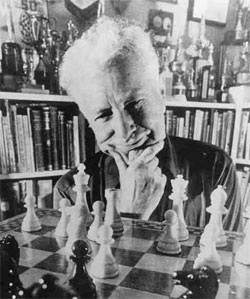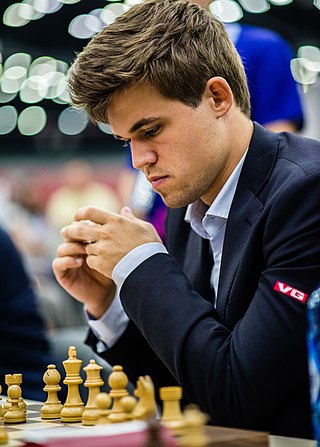Elo rating system
The Elo system was invented by Arpad Elo and is the most common rating system. It is used by FIDE, other organizations and some Chess websites such as Internet Chess Club and chess24.com. Elo once stated that the process of rating players was in any case rather approximate; he compared it to "the measurement of the position of a cork bobbing up and down on the surface of agitated water with a yard stick tied to a rope and which is swaying in the wind". [8] Any attempt to consolidate all aspects of a player's strength into a single number inevitably misses some of the picture.
FIDE divides all its normal tournaments into categories by a narrower average rating of the players. Each category is 25 rating points wide. Category 1 is for an average rating of 2251 to 2275, category 2 is 2276 to 2300, etc. Women's tournaments currently commence 200 points lower, including its Category 1. [9]
| Rating range | Category |
|---|---|
| 2700+ | No formal title, but sometimes informally called "super grandmasters" [11] |
| 2700–2500 | most Grandmasters (GM) |
| 2499–2400 | most International Masters (IM) and some Grandmasters (GM) |
| 2399–2300 | most FIDE Masters (FM) and some International Masters (IM) |
| 2299–2200 | FIDE Candidate Masters (CM), most national masters (NM) |
| 2199–2000 | Candidate masters (CM) |
| 1999–1800 | Class A, category 1 |
| 1799–1600 | Class B, category 2 |
| 1599–1400 | Class C, category 3 |
| 1399–1200 | Class D, category 4 |
| 1199–1000 | Class E, category 5 |
| Below 1000 | Novices |
The USCF uses the USCF system, a modification of the Elo system, in which the K factor varies and it gives bonus points for superior performance in a tournament. [12] USCF ratings are generally 50 to 100 points higher than the FIDE equivalents. [13]
| Category | Rating range |
|---|---|
| Senior master | 2400 and up |
| National master | 2200–2399 |
| Expert | 2000–2199 |
| Class A | 1800–1999 |
| Class B | 1600–1799 |
| Class C | 1400–1599 |
| Class D | 1200–1399 |
| Class E | 1000–1199 |
| Class F | 800–999 |
| Class G | 600–799 |
| Class H | 400–599 |
| Class I | 200–399 |
| Class J | 100–199 |
Example
Elo gives an example of amending the rating of Lajos Portisch, a 2635-rated player before his tournament, who scores 10½ points of a possible 16 winning points (as this is against 16 players). First, the difference in rating is recorded for each other player he faced. Then the expected score, against each, is determined from a table, which publishes this for every band of rating difference. For instance, one opponent was Vlastimil Hort, who was rated at 2600. The rating difference of 35 gave Portisch an expected score of "0.55". This is an impossible score as not 0, 1⁄2 or 1 but as this is higher than 0.5 even a draw will very slightly damage Portisch's rating; conversely a draw will very slightly improve Hort's rating.
Portisch's expected score is summed for each of his matches, which gave a total expected score of 9.66. Then the formula is:
- new rating = old rating + (K × (W−We))
K is 10; W is the actual match/tournament score; We is the expected score.
Portisch's new rating [14] is 2635 + 10×(10.5−9.66) = 2643.4.
Linear approximation
Elo devised a linear approximation to his full system, negating the need for look-up tables of expected score. With that method, a player's new rating is
where Rnew and Rold are the player's new and old ratings respectively, Di is the opponent's rating minus the player's rating, W is the number of wins, L is the number of losses, C = 200 and K = 32. The term (W-L) / 2 is the score above or below 0. ΣD / 4C is the expected score according to: 4C rating points equals 100%. [15]
The USCF used a modification of this system to calculate ratings after individual games of correspondence chess, with a K = 32 and C = 200. [16]





